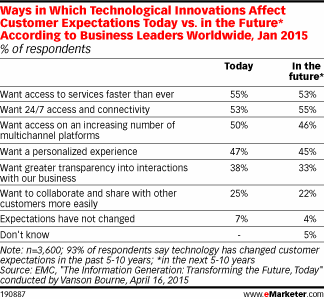Content Provided by AspenCore and Microchip.
The information age has inspired speedy and personalized consumer experiences, intensifying the customer’s need to seek out the best product available. Prospective buyers now have increased knowledge of brands, consequently forcing developers to innovate and improve their products even further to keep up with customers’ awareness. While every sector of the online market feels this pressure, marketers face a bigger demand than ever before to stay up to date on the latest technology and end-users opinions so that they can surpass competitors in selling electronics.
As customers now expect flawless product performance, the pressure to meet their extreme demands has proven to cause companies to struggle, suggesting that the act of redefining product and marketing remains a work in progress. A May 2015 poll conducted for the software company Lithium reported that 82% of U.S. corporate executives believed that customers’ expectations of their company were “somewhat” (47%) or “much” (35%) higher than they were three years prior. Of the executives polled, the majority also felt that satisfying customers has become increasingly difficult, largely due to the high expectations that Internet and consumer app companies have established over the years. These technological expectations have grown out of factors such as constant interaction with product ads (often popping up on people’s social media feeds or even during their web browsing) and companies’ data analytics displaying what consumer behavior tends to lean towards.

With the Internet of Things (IoT) era beginning to settle in, the consumer electronics industry is once again poised to boom, encouraging key players to act quickly in the hopes of cornering the market before it matures. To establish an early foothold, companies must “push disruptive innovation by connecting humans with technology in ways that meet their fundamental needs,” suggests an Accenture Consulting report.
Facing customers who are well informed and up to date, companies must use high-tech marketing tools to both understand their audience and gather the necessary data to formulate products specifically matching consumers’ needs. For example, Lego now has kiosks that identify the boxed item a customer may hold up and then display the completed model as if the customer was holding it. Many beauty and clothing retailers also have systems that scan a user’s face or body and apply a product or piece of clothing to the image. While information found online is crucial to the growth of the electronics market, these in-person systems also promote finding the product best suited for the customer.
As a result of smartphones and easy shopping experiences encouraging growth of online retail, U.S. e-commerce has grown by almost 18% a year over the past decade. According to a feature on The Next Web, millennials are largely responsible for affecting changes within the market, as they count for nearly a quarter of the population and rely heavily on each other for information about new things. “Millennials see technology not just as a device or platform for communication but as a way to improve life, make better choices, and contribute to society,” wrote columnist Jamie Gailewicz.

Along with a seemingly inborn ability to navigate the web for reliable content, millennials enjoy informing others about what to expect of a product, as seen with the popularity of informal product reviews and online forum discussions of certain brands. This raises a new critical aspect of marketing: consumers know they have a plethora of choices when buying something. “This group will challenge, expect more, and desire a better idea for how to live,” said Gailewicz. “This generation is just realizing its purchasing power; as another decade passes, the brands they have built relationships with today will be the ones they are loyal to tomorrow.”
However, millennials aren’t the only ones who are readily contributing to today’s tech sales – a 2010 study showed that baby boomers actually spend the most money on the latest technology. An AdvertisingAge piece states that the secret to reaching older customers in the electronics market is to determine what tech is relevant to them. “I think the biggest difference in the way boomers use technology versus the younger generations is that we tend to see it as a way to get something done – whether that’s something at work or staying in touch with friends and family,” said Marilynn Mobley, a baby boomer who uses a desktop, laptop, iPad, and smartphone. “Gen X and especially Gen Y just see it as a part of life.”

Whether customers are inspired to purchase new products out of necessity or to stay current with the latest trends – which is to say that marketing has successfully done its job – there is clearly no specific age range that electronics appeal to anymore. Regardless of age, customers are prepared to do research on their options. Online reviews, both professional and informal, have grown to be undeniable factors in a product search. A 2013 survey revealed that 90% of respondents said positive product reviews affected their final decisions, while 86% claimed negative reviews played a part in deciding to purchase or not. Figures even show that reviews on Facebook – most likely coming from within your immediate network – were mostly positive, while negative ones came from online review sites. Feedback of this nature suggests that even though professional review sites may know how to thoroughly evaluate products, consumers are prone to trust the opinion of a friend, or even distant acquaintance.
Given the ubiquitous nature of modern electronics, the proliferation of consumer reviews makes sense – enough of the population understands how to use consumer-centric technology that nearly anyone can voice their opinion about a specific product. Couple that with the fact that most consumers have less at stake and more likely to be honest, and it’s easy to see why consumers prefer feedback from their peers. Case in point, a 2010 report shared that consumer reviews are trusted up to nearly 12 times more than manufacturer reviews, highlighting the growing importance placed on pleasing your audience from the onset.
Such a heavy reliance on product reviews has consequently caused the search for items to become even more precise. Having so many customers’ opinions about products enables companies to create products closely aligned with their consumer vision. The Deloitte Consumer Review reads, “The customer journey is now more of a cycle, where one consumer’s experience feeds into another consumer’s decision process whether to buy a product or a service.” With so much useful data about audience demand, companies have no excuse not to adjust their products to fit customers’ ideals. Companies employing consumer ideas or suggestions can also improve conversion rates and how much customers trust the business.
Although the drive to succeed may now be intensified for developers in the electronics market, technology has ultimately introduced extra personal interactions between company and customer into the market. The information age has allowed consumers to contribute their voices to the manufacturing process, directly telling companies what works and what fails to impress. With this collaborative relationship in place, the future holds the possibility of higher product success and happier, devout customers.
Content Provided by AspenCore and (client).
Source: Deloitte Consumer Review, Econsultancy, Marketing Land, AdvertisingAge, The Next Web, McKinsey&Company, Perficient, Accenture Consulting, Emarketer
Advertisement
Learn more about Electronic Products Magazine





